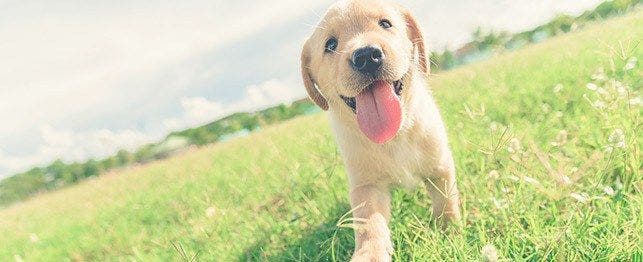
Why are Puppies so Soft?
When puppies are little, they have several distinct features that differentiate them from their adult counterparts: big round eyes, huge paws, large ears, and fluffy coats. Your puppy will grow into his eyes, ears, and feet, but his coat will go through a dramatic change. While most dogs will still be soft once they’ve grown into their adult bodies, their coat will go through a startling transformation. Your lovable fluffball will always be soft to the touch, but he won’t retain that almost excessive softness that he had when he was little. So why are puppies so soft?
The Type of Fur
When puppies are little, their undercoat is what is most pronounced. Their outer coat is still growing and has yet to grow past their fluffy undercoat. That’s why puppies are so soft as babies; because they haven’t grown out their outer coats yet. But, your puppy’s undercoat will never go away, it will just be protected by a layer of overcoat eventually.
Most breeds of dog have three distinct fur types: tactile hair, outer coats, and undercoats. First, the tactile hairs are the sensory hairs that are primarily found as whiskers and stiff hairs on the eyebrows, chin, and sides of the face. Never cut your dog’s tactile hairs. Tactile hairs help dogs to navigate and test their surroundings, without them dogs can easily injure themselves and acquire a disjointed sense of balance.
Next, a puppy’s outer coat is composed of guard hairs. This layer of fluff is also called the primary hair. These are the long, smooth, and stiff hairs that generally grow through the undercoat to cover your dog. Each breed’s overcoat will look different and may perform even slightly different functions, but at its root, all overcoats serve to protect your dog from the elements. Some breeds have a water-wicking coat, like Labs and Hounds, which makes them idea hunting companions. Others have short, wire like hair which makes them ideal for tunneling and chasing game, such as Jack Russell Terriers and Westies. There are many diverse types of overcoats, and each one performs a specific job.
Lastly, the undercoat. The undercoat is called the secondary coat and is made of short soft, dense hair and primarily supports the outer coat. Some breeds have larger undercoats than others. Breeds that were bred in the north, like Huskies and Malamutes for example historically needed larger undercoats to keep them warm for hours in the snow. However, some dogs have little to no undercoat and instead have a hair overcoat. These breeds were typically bred in warmer climates where they didn’t need a dense undercoat for survival. Some of these breeds include Poodles, Yorkies, Chihuahuas, and Greyhounds.
Why The Length of Hair and Fur Matters
If we go by the “more is better” rule, then, in theory, Yorkies would be some of the fluffiest and warmest dogs around. But in fact, this breed’s outer coat is made of hair and not fur, and while there may be a lot of it, Yorkies need help to keep warm in the winter from man-made jackets.
The length of a dog’s hair or fur matters. When each breed was developing, its hair or fur length was determined based on how much protection that dog needed form the elements. In tropical areas, we history saw very short hair breeds developing. This was because short hair allows heat to be dissipated easier than long hair, and the short hair gene is dominant, meaning that a dog with short and long hair parentage will most likely retain one of its parent’s short hair.
Long-haired breeds, on the other hand, tend to have developed in the colder climates since longer hair provides more insulation and warmth. With selective breeding, the early breeders were able to cultivate dogs that had longer hair than those before resulting in popular northern breeds.
The Difference Between Fur and Hair
Most people interchange the words fur and hair when talking about a dog’s coat, but in some cases, these terms do not mean the same thing. The biggest difference between fur and hair is the undercoat or lack thereof. A double coated dog is a breed that has an undercoat and an overcoat, this is the most common among the coat varieties, and we usually switch between calling the coats on these dogs fur or hair. But some dogs don’t have an undercoat, leading us to refer to their coat as hair. Below are some of the most common examples of furry and hair dogs.
Hairy Dogs
Maltese
Shih Tzu
Brussels Griffon
Portuguese Water Dog
Poodle
Yorkshire Terrier
Westie
Furry Dogs
Pomeranian
Australian Shepherd
Chow Chow
Malamute
Pembroke Corgi
Husky
Akita
Will Your Puppy Stay Fluffy?
Well, that all depends on its breed. If you’ve brought home a double coated pup, then he’ll remain soft, but a coarser overcoat will eventually grow out to overtake his undercoat. If you took home a dog who doesn’t have a double coat, then he will most likely end up being silkier rather than fluffy. And if you brought home a breed with neither hair or fur, such as a Chinese Crested or an American Hairless Terrier, then your pup is going to stay bald, and that’s ok! No matter what your dog looks like, we know that you’ll love them just the same.